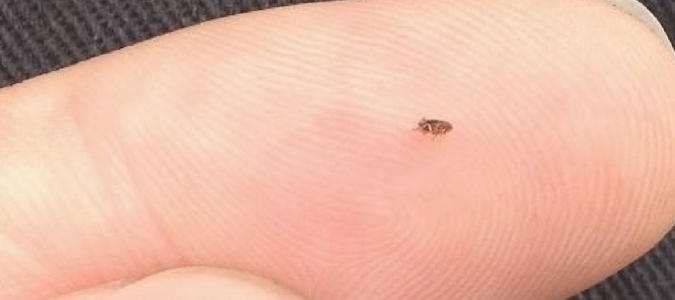Waking up in the morning with itchy bites on your skin is no fun. Not only are you uncomfortable from all the itching, but you’re also now aware that you have a pest problem to deal with. Fortunately, it’s not hard to learn how to get rid of fleas on your mattress so you can sleep comfortably once again.
First, of course, it’s a good idea to determine whether you’re dealing with fleas or some other type of pest. After all, there are other types of pests that can cause itchy bites, like mosquitoes or bed bugs. Both flea bites and mosquito bites might happen at any time of day or night, and both leave itchy red welts that soon fade and get less itchy for most people. Bed bugs, on the other hand, typically venture out only in darkness to bite people while they sleep. Also, most people find bed bug bites quite a bit itchier than flea or mosquito bites, and they stay itchy longer. They might even blister, which flea and mosquito bites rarely do.
If you’re dealing with a flea infestation in your bed, you’ll probably see at least one or two actual fleas. Fleas are tiny, black, wingless insects that can crawl quickly and jump a foot into the air. They’re about the size and color of a speck of black pepper, so they can be hard to spot, but they’re definitely visible. Bed bugs, on the other hand, are larger than fleas. They are about the size, shape and color of an apple seed. However, since they usually venture out in the darkness, spotting one crawling on your sheets is pretty rare.
People with pets that spend time in their beds are more likely to have a flea infestation in the bedroom. That said, even if you don’t let your pet into your bed, your mattress could still become infested with fleas. This can happen when a dog scratches due to itchy flea bites and shakes its whole body, which can accidentally shake flea eggs onto the bed.
If you believe you have fleas in your mattress or your bed, you’ll need to treat the mattress itself along with your sheets and blankets. But, it’s best to treat your pets first. Unfortunately, fleas reproduce very quickly and females can lay up to 50 eggs a day. Their eggs are tiny and smooth, so while the adult fleas continue living on your pet’s body, the eggs drop out of the animal’s fur into your bed, carpet or floor. They’ll stay there until they hatch—or until they’re removed.
The first thing to do if you think you have fleas in your mattress is to contact your veterinarian. Your vet can give you their recommendations for the best ways to treat your pets for fleas. Once your furry friends have been treated, it’s time to wash and dry all your bedding on the hottest settings possible to kill off fleas, flea eggs and larvae. Next, vacuum your mattress and floor as thoroughly as possible. You’ll also need to wash your pet’s bedding and vacuum the whole house thoroughly. Be sure to pay special attention to the areas where your pet spends the most time, as these are likely to be the spots where there are flea eggs.
Some people try using flea insecticides that are available at grocery or hardware stores. The trouble with many of these products is that they only target adult fleas, while missing flea eggs and larvae completely. Using these products might kill off the fleas that are actively biting you, but in a couple of weeks, your flea problem will seem to return. These “new fleas,” of course, are just the former eggs and larvae that have since hatched and developed into adult fleas in search of a blood meal.
It’s possible that frequently washing your pet’s bedding and your own, regularly vacuuming the house and other do-it-yourself methods can help fight a minor flea infestation. But, if you have a heavy infestation, these techniques could just prolong the problem. Getting help from a reputable pest control specialist is the best way to deal with a significant flea problem. This is especially true if the fleas have infested an area like your bedroom where you spend lots of time and need to be comfortable.
Getting rid of fleas usually requires using several techniques in combination instead of one single approach. For example, you may need to have your yard treated to keep your pets as flea-free as possible, as well as your house and your pets themselves. A pest management professional can recommend a customized, multi-pronged approach to address your pest problem.
When dealing with a flea problem, you likely have a lot of questions. Like, what are fleas attracted to? And, how did your pets get fleas in the first place? Keep reading to find out.
What Are Fleas Attracted To?
So what are fleas attracted to—what draws them into your yard or your home and makes them want to stay? Fleas don’t come into your yard on their own; they are introduced to your environment on an animal host. Usually, this means wild animals like raccoons or squirrels that visit your yard for food, water or shelter. If they bring fleas along with them, soon enough, your dog or cat that spends time outdoors will have fleas too, and will bring these pests indoors.
Fleas are attracted to warmth, moisture and light, all of which can be found in most people’s homes. Most of all, though, fleas are attracted to animal hosts that can provide them with the regular blood meals they need to survive and reproduce. In most homes, this means dogs or cats, but fleas can exist in a pet-free home. This happens if wild animals like raccoons, squirrels or rats nest in some part of your home, such as the attic or inside the walls. If they have fleas, they could introduce them into your home.
The thing is, fleas aren’t just annoying; they’re actually potentially dangerous. Their bites can cause allergic reactions in both people and pets, and fleas can also cause tapeworms and other serious illnesses in pets. This is why it’s so important to treat a flea problem as soon as you’re aware of it, so it doesn’t get further out of control. With female fleas laying 50 eggs a day, and those eggs taking just a week or two in warm weather to develop into adult fleas, it’s easy to see how fast a minor problem can turn into an infestation.
Warmth is actually an important factor in flea development. Flea eggs hatch into larvae, and then the larvae spin cocoons where they’ll spend time as pupae before emerging as adult fleas. The process from egg to adult flea can take as little as one week if it’s warm enough. When it’s colder, flea pupae can stay in their cocoons for many months, waiting for the right conditions to come out. Fleas inside their cocoons can actually sense a nearby host by the host animal’s vibrations.
As fascinating as the flea life cycle might be, if you think you have a flea problem in your home or yard, it’s time to contact a pest control professional. This is often the most efficient way to determine the scope of the infestation and to treat the pests as thoroughly as possible.
Once you’ve dealt with a flea issue, you likely want to know what you can do to prevent a future problem. So, where do dogs get fleas? Is there a way you can avoid those areas to prevent another problem?
Where Do Dogs Get Fleas?
If your dog has been scratching a lot, there’s a good chance Fido has a flea problem—which means your house could have one, too. Once you figure out your dog has fleas, you’re probably wondering where it all started. Where do dogs get fleas?
Unfortunately, they can get them from a lot of places, including your very own yard. Wild animals that spend time in your yard like squirrels or mice can introduce fleas that then end up on your pets.
But the yard isn’t the only place where your dog could have picked up fleas. They can also get fleas at the groomer, a boarding kennel or a “doggie daycare” facility. Basically, anywhere your dog spends time that has other animals present is a potential source of fleas that Fido could bring home.
Flea infestations can be tricky to deal with because these tiny insects are so prolific. Once they start laying eggs, there are fleas present in all different stages of the life cycle, with new adult fleas biting you and your pets every day. This is why getting rid of fleas takes vigilance and continued effort. Don’t expect to just treat your pet once, wash your sheets, vacuum your floor and be done with it. Pest control professionals know that multiple treatments, and several different products and techniques, will likely be needed before your flea problem is under control.
Even then, it isn’t guaranteed that you’ll never deal with fleas again, since your dog or cat could re-introduce them to your home at any point. The good news is that once you’ve learned helpful techniques for managing a flea infestation, including enlisting help from a pest control professional, you’ll know what to do if your pest problem returns in the future.
ABC Can Treat the Fleas on Your Property
Instead of scratching at terribly itchy bites, contact ABC Home & Commercial Services. We will create a strategic plan to eliminate these pests inside and outside of your home. That way, you and all the members of your family can be comfortable again.


